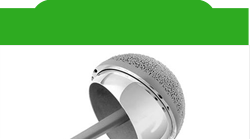1 month Post-op, with Stretching Exercises

Edwin P. Su, MD
Hospital for Special Surgery
(212)606-1128
Specializing in Joint Reconstruction
You should now be comfortable in walking with 2 crutches, placing full weight on the operated leg. At this point, if you haven’t already done so, you may wean to using 1 crutch or cane in the opposite hand/arm. I like to think about your rehabilitation in 3 phases:
- Phase I (day 1 to 1 month postop)- acute post-operative; mainly concentrating on walking correctly and doing some simple exercises
- Phase II (1 month to 4 months postop) - stretching exercises to regain hip flexibility and range of motion, gentle strengthening
- Phase III (3 months to 1 year postop)¬ - strengthening exercises
Note: there is some overlap between the phases, and patients will feel ready for the next phase at different timepoints. The timings are only rough guidelines for your reference.
After surgery, you will experience the formation of scar tissue. This scar tissue will form not only at the incision site, but also deep within the joint. It is common at this point to still have a feeling of stiffness, particularly if you have stayed in one position for too long. I recommend changing position every 1-2 hours to avoid this feeling.
During Phase II, the goal is to stretch out this scar tissue while it is still pliable. You will continue to gain motion for up to a year, but it is easier the earlier we start. I recommend doing the following exercises daily, 3 to 4 times per day. In addition, I will prescribe outpatient therapy to have a physical therapist assist with the strengthening aspect.
These 4 exercises should be done on your own to increase flexibility:
1. "Jack-knife": This exercise is designed to help stretch out the anterior, or front portion of your hip joint. This will include stretching the hip flexor tendons. It is done as follows:- Lie on a firm surface, on your back. Bring both knees up to your chest as high as they will go. This flattens your back against the surface and locks your pelvis. Then, hold your un-operated knee up to your chest with both hands. Slowly lower the operated leg to the surface. When you feel the stretch in the front of the joint, tighten your abdominals, and then force it even flatter. Hold for 10-15 seconds. Repeat for a set of 10. Advanced: When you no longer feel the stretch, you can lower the hip over the side of a bed for an additional stretch.
 Starting Position |
 Stretching of the LEFT hip |
 Advanced stretching (off bed) |
 Modified (opposite knee bent on table) |
2. "Child's Pose": This is a yoga pose, designed to increase flexion and stretch out the posterior, or back of your hip joint. It is done as follows:
- Carefully get on your hands and knees. Place your knees shoulder width apart. Stick out your buttocks to arch your back slightly; this will lock your pelvis into correct position. Now, gently rock your buttocks towards your heels, with the eventual goal of sitting on your heels. Tuck your chest, head and shoulders towards your knees. When you feel the stretch, hold for 10-15 seconds. Do not rush this exercise in an attempt to sit on your heels. Repeat for a set of 10.
 Starting Position |
 Ending position |
3. "Dangle": This is a simple exercise to help increase flexion.
- Just find a stool or lower chair. Place your knees at shoulder width. Bring your hands down towards your ankles and hold when you feel the stretch. Don't bounce or continue if you have a lot of pain. Repeat for a set of 10.

- In a sitting position, gently grab your operated foot and bring it to rest on your unoperated knee. This will bring you into a sitting, cross-legged position. It will be difficult at first, and you may feel some pain around the incision site. If it is too stiff to accomplish this early on, you may turn your body at an angle to the chair/bed, and bring the foot onto the chair/bed instead of your opposite knee. Gently press on your operated leg to flatten it.
 Stretching of RIGHT hip in Figure 4 |
 If too difficult, begin lying down |
In addition to these exercise and your physical therapy, you can continue to increase your activity. I still recommend swimming the breaststroke, riding a bicycle, and walking. As you become confident in cycling, you can venture onto the road, as long as you don't fall.
You can use an elliptical machine when you no longer use a cane or crutch.
In terms of strengthening exercises, I recommend particularly the exercise of side-raises (abduction). This will stabilize your pelvis and eliminate a limp.
In the beginning, you will not have the strength to lift the leg unsupported, so I recommend starting with "clamshell" exercises:
 Starting position |
 Ending Position |
Advanced abduction exercises (with operated leg unsupported):
To do this properly, you should lie on your unoperated side. Place your operative leg slightly behind your torso (in extension) and raise slowly. You can do this while lying against a wall, placing light pressure of your operated heel against the wall to ensure you are doing it correctly.
In the next few months, you can gradually return to sports. Remember to listen to your body.You can begin swinging a golf club or tennis racquet at about 2 months after surgery. With golf, you should work on your short game first. With tennis, you should hit ground strokes in place before chasing down balls. An improved range of motion will help with both of these sports. After completing outpatient PT, you can do some yoga to continue with stretching, if desired.
I would like you to be comfortable putting on your shoes and socks by 3 months postoperative. Remember that stretching is a dynamic process and will continue to improve. I would like you to refrain from running, jumping, or carrying over 50 lbs until 6 months postoperative. Otherwise, you are free to enjoy your new hip!
"Thank you to DynamicSportsPT.com for the video demonstrations!"
The Center for Hip Pain & Preservation
541 East 71st Street
New York, NY 10021
 Click here for Driving Directions
Click here for Driving Directions

















